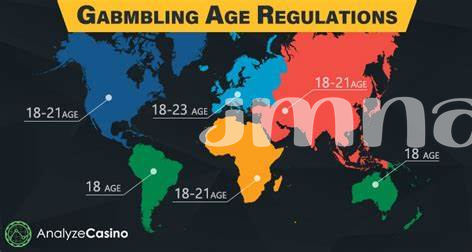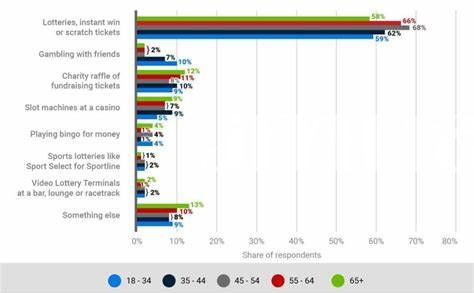Dive into the Specifics of the Age for Gambling in Canada, Unveiling the Legal Stipulations and Insightful Reasons Behind These Regulations.
Exploring the Reasons Behind Canada’s Gambling Age Limits
- 🍁 Setting the Scene: Canada’s Unique Gambling Landscape
- 🎂 Age of Majority: a Provincial Patchwork Quilt
- 🚦 Reducing Risk: the Logic Behind Age Limits
- ✨ Beyond Age: Other Factors Influencing Canadian Regulations
- 🌐 a Global Comparison: How Canada Stacks up
- 🔄 Changing Times: Future Trends in Gambling Laws
🍁 Setting the Scene: Canada’s Unique Gambling Landscape

Within the vibrant expanse of Canada, the gambling landscape unfurls as a colourful tapestry, interwoven with a medley of regulations that underscore the nation’s commitment to safe and responsible gaming. This unique terrain is not just a shrine to the thrill of chance but also a reflection of Canada’s prismatic cultural and legal framework. Each province, boasting its own set of rules, paints a distinct picture of gambling, much like a patchwork quilt, varying from the breezy Atlantic coast through to the rugged mountains and bustling cities. Amid this diversity, common threads emerge, such as the universal enticement of the lottery and the widespread allure of casinos, each humming with the echoes of hopeful fortune-seekers. Yet, it’s not all about luck and leisure; this landscape is carefully curated to balance enjoyment with ethical gaming practices.
Delving deeper into teh fabric of this scene reveals not just a penchant for games of chance, but a sophisticated structure designed to protect and guide both seasoned players and novices alike. Goverment regulations are meticulously crafted, ensuring that activities like the spin of the roulette wheel or the shuffle of cards occur within a safe and monitored environment. This regulatory cocoon wraps around a variety of gambling venues, including the high-octane floors of casinos, serene bingo halls, and the digital realm of online betting, each adhering to standards that seek to uphold the integrity of gaming in Canada. Moreover, the accessibility of gambling forums is augmented by modern technological conveniences, such as mobile betting apps and online platforms, which are regulated to ensure fair play and protect the user’s well-being. The dialogue between tradition and innovation in this sphere is ever-present, merging the timeless allure of gambling with the forward thrust of technological advancement.
| Province | Legal Gambling Age |
|---|---|
| Alberta | 18 |
| British Columbia | 19 |
| Manitoba | 18 |
| New Brunswick | 19 |
| Newfoundland and Labrador | 19 |
| Nova Scotia | 19 |
| Ontario | 19 |
| Prince Edward Island | 19 |
| Quebec | 18 |
| Saskatchewan | 19 |
Amidst this rich tapestry, the gambling age—a cornerstone regulation—stands as a testament to Canada’s dedication to fostering a responsible gambling culture. This woven narrative of diverse practices and protective measures not only showcases Canada’s approach to gambling but also sets the stage for an ongoing evolution of the landscape, where safety and enjoyment are held in perfect balance.
🎂 Age of Majority: a Provincial Patchwork Quilt

In Canada, the journey to determining the age for gambling isn’t a straightforward path but rather a complex mosaic akin to a provincial patchwork quilt. Each province and territory has been bestowed the authority to set its own legal gambling age, wich results in a diverse tapestry of regulations stretching from coast to coast. This decentralised approach means that while some regions set the threshold at 18, others have opted for 19 as the magic number. Such disparity raises questions about the rationale behind these decisions and highlights the importance of understanding local cultures and societal norms in shaping these laws.
The logic behind setting different age limits across provinces ties back to the broader concept of the age of majority, which signifies when a person is considered legally an adult. This milestone does not only pertain to the ability to gamble but extends its reach to other markers of adulthood, such as the right to vote and consume alcohol. Considering gambling in the same legal framework as these other adult activities underscores the significance of these age limits as safeguards designed to protect younger individuals from making potentially harmful decisions during their formative years.
Moreover, the variation in legal gambling ages across Canada reflects a tailored approach to addressing the unique social and economic landscapes of each province. It’s akin to prescribing a specific script or comp for an ailment; what works for one region might not suit another. This bespoke strategy ensures that the laws resonate with the local populace, taking into account factors such as cultural attitudes towards gambling and prevalent socio-economic conditions.
The dialogue surrounding age limits for gambling in Canada is reflective of a broader debate on individual maturity and societal responsibility. As we consider the fabric of Canadian gambling laws, it’s clear that these regulations are not merely arbitrary figures but are rather a reflection of a careful balancing act. They aim to usher young Canadians safely into the realm of responsible gambling while respecting the diverse tapestry that is Canada’s provincial autonomy. This ongoing conversation continues to evolve, possibly heralding changes in how we view and legislate gambling for future generations.
🚦 Reducing Risk: the Logic Behind Age Limits

Setting the age for gambling in Canada is more than just picking a number that seems right; it’s a carefully considered strategy aimed at reducing risk and fostering responsible gambling. The decision to set these age limits varies across provinces, reflecting a patchwork quilt of policies tailored to the demographical and cultural nuances of each region. This approach acknowledges that while the thrill of a wager might have universal appeal, the maturity required to handle the potential consequences of gambling does not sprout overnight. By pegging gambling age to the age of majority, provinces send a clear message: the transition into adulthood brings with it the privileges and responsibilities of engaging in gambling activities. This policy mirrors the understanding that the adolescent brain is still in development, potentially making younger individuals more susceptible to impulsive behavior and the allure of risk-taking associated with gambling.
However, the rationale goes beyond neuronal development and veers into the realm of social responsibility. Goverment authorities and regulators aim to shield young individuals from the financial strains and potential pharm party-like addiction scenarios that gambling can precipitate. Stats suggest that early exposure to gambling increases the likelihood of developing gambling-related problems later in life. Blocking access untill individuals reach a mature age is believed to mitigate these risks, acting like a safety cap does in preventing overdose from fridge drugs. These measures, evolving out of both caution and care, reflect an ongoing commitment to public health and the prevention of gambling-related harm, ensuring the deck is stacked in favor of promoting well-being rather than courting preventable misfortune.
✨ Beyond Age: Other Factors Influencing Canadian Regulations
While the age for gambling in Canada is a significant factor in safeguarding its citizens, what we often overlook are the other layers of protection woven into the regulatory fabric. The Canadian approach is multifaceted, considering not just chronological maturity but also the mental and social readiness of individuals to engage in gambling activities. For instance, the pharmacological impact of gambling – akin to the ‘happy pills’ that alter mood and perception – is a critical consideration. The goverment actively evaluates how gambling’s dopamine-triggering effects parallel those of controlled substances, adapting their stance as new research emerges about addiction and its treatment.
Further, the concept of ‘harm minimisation’ takes centre stage, incorporating strategies beyond mere age restrictions to prevent gambling-related harm. This includes rigorous checks and balances such as self-exclusion programs and limits on gambling advertising, echoing the careful regulation seen in ‘Pharm Land’ where prescriptions and OTC medications are dispensed. These preventative measures are as crucial as the safety cap on a vial of potent medication, designed to protect vulnerable populations from the potential negative impacts of gambling.
It’s also worth highlighting the role of technology in enforcing these regulations. The rise of online gambling has prompted a shift towards digital solutions for age verification and responsible gaming practices. Much like the ‘robot’ in a modern pharmacy that ensures accuracy and safety in medication dispensing, cutting-edge tech plays a pivotal role in the secure and ethical operation of gambling platforms across Canada.
Lastly, engagement with Indigenous communities offers a unique dimension to Canada’s regulatory framework. Recognising the sovereingty of First Nations, the governemnt often works in partnership with these communities to establish gambling regulations that respect cultural values and traditions. This collaborative approach ensures that the benefits of gambling, such as economic development and community funding, do not come at the cost of social and cultural integrity. Through this lens, Canada’s gambling regulations are a mosaic of considerations – age, psychological well-being, societal impact, and respect for cultural heritage – each playing a vital role in shaping a responsible and inclusive gambling environment.
🌐 a Global Comparison: How Canada Stacks up

When comparing the age for gambling in Canada with other countries, it becomes apparent that there is a significant diversity in how nations approach this aspect of regulation. Canada, with its provincial autonomy, allows for a patchwork of laws wherein the gambling age varies from 18 to 19 depending on the province. This decentralized approach is somewhat unique, differing notably from countries with a uniform national age limit. For instance, in the United States, the legal age for gambling is generally 21, with minor exceptions. Across the Atlantic, the United Kingdom adopts a more lenient stance, setting the legal threshold at 18. This contrast underlines the cultural and legal frameworks that influence gambling regulations globally.
The logic behind these varied age limits is rooted in societal views on maturity and responsibility. In Canada, the age for gambling aligns with other adulthood rights, such as the legal drinking age, indicating a broader perspective on when an individual is deemed capable of making consequential decisions. This contrasts with countries where the legal gambling age is a part of a more extensive legal framework designed to protect younger adults from potential harm. It’s not just about being legally adult but also about having the maturity to engage in activities with significant financial and personal risks. The inclusion of aspects like `Fridge Drugs` or `Happy Pills` rarely enters the conversation directly, yet the implications of addiction and responsible use are undeniably parallel concerns that regulators aim to address, albeit in methods as varied as the cultures themselves.
Comparatively, Canada’s stance on the age for gambling reflects a balance between individual freedom and the protection of its citizens, maintaining a somewhat moderate position in the global arena. As countries continue to evolve their approaches to gambling regulation, considering both the benefits and the pitfalls, Canada’s model offers an interesting case study in balancing liberal values with the welfare of its populace.
| Country | Legal Age for Gambling |
|---|---|
| Canada | 18-19 (Varies by province) |
| United States | 21 (Minor exceptions) |
| United Kingdom | 18 |
Future discussions on gambling laws, especially considering the rapid expansion of online betting platforms, might very well necessitate a revisiting of these age limits. But, as of now, Canada’s stance serves as a thoughtful midpoint in the diverse spectrum of international gambling age laws.
🔄 Changing Times: Future Trends in Gambling Laws
As we chart the future landscape of gambling laws in Canada, it’s essential to recognize the dynamism imbued within the regulatory frameworks, responding to the evolving societal and technological paradigms. Notably, the advent of digital platforms has ushered in a new era, where traditional metrics of regulation face novel challenges and opportunities alike. The confluence of enhanced connectivity with the proliferation of online gambling platforms necessitates a recalibration of regulatory stances, accommodating the digital age without compromising on safeguarding stakeholders. This recalibration might see a blend of traditional oversight merging seamlessly with cutting-edge technology, ensuring a safe gambling environment that resonates with the digital native demographic. It’s plausible that emerging technologies such as blockchain could play a pivotal role, offering a transparent and verifiable system to mitigate concerns around fraud, thus bolstering trust amongst participants.
Moreover, the dialogue around gambling regulations is increasingly characterized by a holistic focus, extending beyond mere age restrictions to encompass a wider spectrum of protective measures. Advocates for responsible gambling are championing for comprehensive strategies that underline education, awareness, and proactive intervention, signifying a shift towards a more informed and protective framework that is attuned to the nuances of gambling risks. Recognizing that the allure of gambling isn’t merely confined to casinos but also pervasive in online realms, regulatory bodies are poised to embrace innovative solutions. This shift might herald the introduction of dynamic tools and resources designed to promote responsible gambling behaviours, potentially incorporating mechanisms such as ‘Happy Pills’ for emotional regulation and ‘Elixir’ for enhancing user experience without compromising safety. Simultaneously, the spectre of ‘Zombie Pills’ as a metaphor for addictive gambling practices underscores the imperative need for vigilant and adaptive regulation. Such initiatives could signify a transformative chapter in Canada’s approach to gambling, making it both accessible and safe for future generations, accentuating an era where regulatory measures are as dynamic and multifaceted as the gambling landscapes they seek to govern. These forward-looking trends epitomize a journey towards not just safeguarding, but also enriching the gambling experience in a manner that’s both responsible and inclusive, marking a definitive stride into the future of gambling laws in Canada.